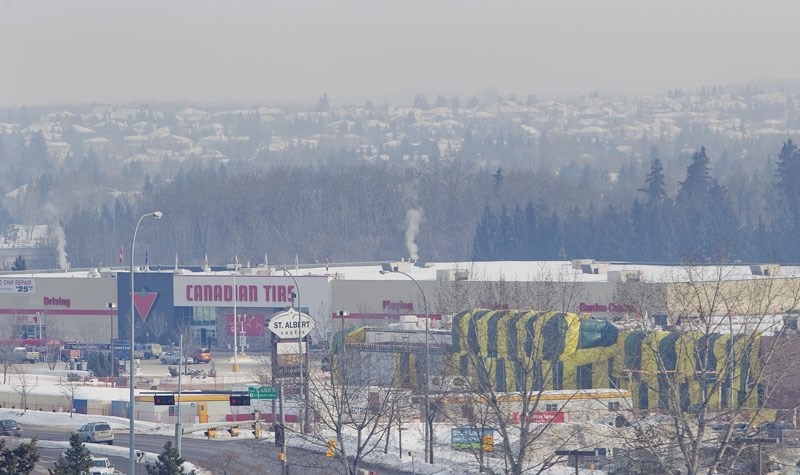Breath easy, readers – that accursed smog is finally gone.
City residents woke up to clear skies Friday for the first time in days after a stationary air mass smothered Edmonton, St. Albert and Morinville with smog.
Alberta Health Services issued a precautionary air quality advisory for the Edmonton region Wednesday that was still in effect as of Friday morning. Residents with pre-existing heart or lung conditions (such as asthma) were advised to reconsider strenuous outdoor activity while the advisory was in effect.
The smog covered low-lying areas of St. Albert with an ugly brown haze Tuesday, and caused near whiteout conditions on parts of Hwy. 2 north of St. Albert Thursday morning. Visibility around the Hwy. 37 overpass was down to about 10 metres.
The fog/smog slowed traffic to a crawl, said Sturgeon County Coun. Tom Flynn, who drove through it on the way to an event in Morinville Thursday, and was thick enough that you could barely see the cars in the opposite lane. “It gave you a disturbing feeling.”
The smog’s cause was a combination of light winds and a temperature inversion, explained Environment Canada meteorologist Dan Kulak.
The atmosphere normally gets colder as you head up, he said, but cold snow can chill the air at ground level enough so that the air above it is warmer, trapping the cold air in place.
Combine that with recent windless conditions, and you get a stationary air mass, said Warren Kindzierski, an associate professor of environmental health and air quality specialist at the University of Alberta based in St. Albert. That lets pollutants such as ozone, nitrogen oxides and fine particulate matter build up in the air to produce smog.
Fine particulate matter is the black stuff that comes out of diesel trucks, and is known to cause asthma attacks and heart disease. Ozone is the haze over hot roads and the smell after lightning strikes, and forms when light reacts with other pollutants. That brown haze comes from nitrogen dioxide, which attacks the lungs.
Many of these pollutants occur when other substances react with sunlight, Kindzierski said – a process that can take several hours. “Where you see it is not necessarily where the emissions occurred.” Some of our recent high ozone levels may have come from as far away as China, he noted.
Alberta Environment ranked Edmonton as an 8 (“high risk”) on its 10-point air quality health index Thursday and a 5 (“moderate”) Friday. It predicted a drop to 3 (“low”) by Saturday.
That wasn’t nearly as bad as it was in past years, Kindzierski said, where forest fires sent particulate matter counts into the 200 to 400 micrograms per cubic metre range. “There’s certainly an opportunity for the air to get a lot worse.”
St. Albert can clean up its air by going after pollution sources, Kindzierski said. “Your big culprit is your motor vehicles,” he said, as they are significant sources of particulate matter and nitrogen oxides. The city’s upcoming air monitoring station would also help us track pollution.
A 2004 study by Alberta Environment found that levels of NO2, SO2, ozone and particulate matter in St. Albert were all normally well below provincial exposure limits for health effects.
Hourly air quality reports are available from www.environment.alberta.ca/apps/aqhi/aqhi.aspx.




